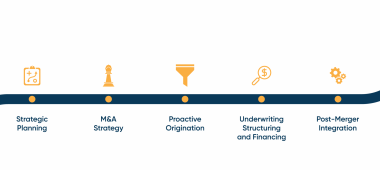This article was originally published in Forbes.
With the popular Paycheck Protection Program (PPP) currently closed and Congressional negotiations over a next round of stimulus stalled, where can a small or middle-market business hit hard by the pandemic turn for capital?
One avenue still open to qualifying companies is the Federal Reserve-backed Main Street Lending Program.
Through low-interest rate bank loans, the MSLP aims to keep credit flowing so private businesses can bounce back; $600 billion was allotted to the program through the CARES Act. Trouble is, banks have not been actively making the loans–through September 30, just $2.3 billion in loans have been issued. But one banks have been in overdrive accounting for every two out of five of these loans nationally.
City National Bank, one of Florida’s largest community banks with $17 billion in assets, has single-handedly fueled 97 of the 252 MSLP loans approved across the country through the end of September. Collectively representing over half a billion dollars of value, it has made MSLP loans ranging from $644,000 to $25 million in industries ranging from professional services and hospitality to construction. CNB was also a big lender in the Small Business Administration’s PPP.
“We knew we had to act quickly and efficiently as the federally-backed loan programs rolled out because, for many of the businesses, obtaining these funds meant the difference between shuttering or staying afloat,” said Jorge Gonzalez, CEO and Vice Chairman of City National, based in Miami. “We have the people and infrastructure necessary to process a high volume of loans, but we also have deep relationships at the local level which allow us to act fast when it comes to educating clients and processing applications.”
Since MSLP is not yet a household acronym, here are a few basics about the program. All loans originated through the MSLP need to be paid back—there’s no forgiveness component, unlike the SBA’s PPP. Companies that meet the Federal Reserve’s criteria will have access to different loan types designed for companies of varying sizes.
MSLP loans, with floating interest rates currently hovering just above 3%, have a five-year maturity and can range in size from $250,000 to $300 million, with a maximum cap of 4 to 6 times the borrower’s adjusted 2019 EBITDA. In order to give companies time to recover, interest payments can be deferred for one year, and principal payments can be deferred for two years. Then 15% of the loan must be paid back in year 3, another 15% in year 4 with the remaining 70% due in year 5. In this current environment, its hard to find a more compelling alternative capital source.
I reached out to Gonzalez to learn more about what borrowers should expect.
David W. McCombie III: Who are the ideal MSLP borrowers? Who is this not a good fit for?
Jorge Gonzalez: Companies with the following characteristics are best positioned to secure a loan through the MSLP:
- A business that was performing well before the pandemic and is likely to do so again post-pandemic
- The ability to demonstrate how long-term capital will help the business navigate through Covid-19 and emerge from the pandemic in a position of stability
- A strong balance sheet, with some level of sustained performance during the pandemic
- Favorable credit rating and history prior to the pandemic
If an organization is a financial services institution, in life insurance, an investment firm among a few additional business-types, it is likely the business will not qualify for an MSLP loan.
McCombie III: What should a borrower prepare ahead of time?
Gonzalez: A potential borrower should review the terms of the MSLP program with their CPA and/or attorney to fully understand the terms of the program and their eligibility to move forward. Potential borrowers should complete a COVID Questionnaire and explain how the MSLP proceeds will be utilized. They should also provide three years of historical financial information together with interim financials for the most recent quarter end and financial projections for the years 2020-2022. Personal guarantors should also be prepared to provide at least two years of tax returns, personal financial statements together with liquidity verification.
McCombie III: What does the approval process and timeline look like?
Gonzalez: We take our employees’ and clients’ health very seriously, so we encourage them to complete most of the process remotely. Our team has put a number of technology-driven systems into place that enables us to accept, process, and fund loans remotely, and in an efficient manner. Underwriting is between 4-6 weeks with expected funding in 7-10 weeks. Upon confirmation of participation by the Fed, funding occurs within three business days.
McCombie III: CNB was ranked 1st in Florida for its PPP performance. Out of curiosity, what was your secret for being so fast to execute?
Gonzalez: CNB made an early commitment to providing capital to businesses and helping to sustain our state’s economic health. We knew back in March that the chance of economic disruption was significant due to the virus, so we took early steps to prepare for the possibility that there would be federally-backed lending programs put into place. Once PPP applications started pouring in, our team acted quickly and worked tirelessly to get as many processed as possible, on behalf of both clients and non-clients. This was a full team effort, backed by several systems and technology platforms that have kept the process streamlined and seamless.
We set up a virtual “war room” and trained employees from every corner of our business on how to process loan applications. This resulted in CNB ultimately funding about 9,500 PPP loans totaling almost $2 billion. That amounts to about a full year’s worth of lending, and we did it in the span of a month. In the end, the loans we funded helped preserve as many as 250,000 jobs.










